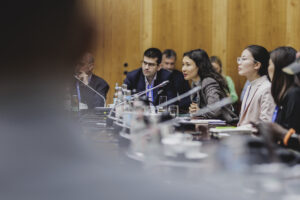BERLIN – Experts discussed ways to realize Kazakhstan’s green hydrogen production ambitions by overcoming high production costs, market ambiguity, and water sustainability challenges in Central Asia during the 10th Berlin Energy Transition Dialogue (BETD) in Berlin on March 19-20.

From L to R: Moderator Melinda Crane, Oman’s Minister of Energy and Minerals Salim Al Aufi, Namibia’s Minister of Mines and Energy Tom K. Alweendo, Policy Director for Emerging Technologies, Climate & Clean Energy Program at the Natural Resources Defense Council Rachel Fakhry, Kazakhstan’s Vice Minister of Energy Sungat Yessimkhanov, CEO of the Green Hydrogen Organisation Jonas Moberg, Ukrainian Deputy Minister of Energy Svitlana Grynchuk. Photo credit: Photothek /BETD
Hydrogen, especially green hydrogen, is expected to be a critical fuel of the future, replacing natural gas as economies and industries transition to a low-carbon world. It comes in various forms, including blue, grey and green. Blue and grey hydrogen are produced from natural gas, while green is derived from electricity generated from solar and wind power plants.
Kazakhstan, with its ample renewable energy sources and vast tracts of available land, might become a leading producer of green hydrogen.
Kazakhstan’s role in green hydrogen development
Kazakhstan’s delegation, headed by Vice Minister of Energy Sungat Yessimkhanov, participated in BETD’s Sustainability Standards in Green Hydrogen panel session on March 20, addressing Kazakhstan’s role in green hydrogen development.

Kazakhstan’s Vice Minister of Energy Sungat Yessimkhanov (second from R) speaking at BETD’s panel on Sustainability Standards in Green Hydrogen. Photo credit: Photothek /BETD
Last year, Kazakhstan launched test drilling of its Hyrasia One project, a major green hydrogen production plant in the Mangystau Region that will oversee the production of green hydrogen and its derivatives, such as ammonia.
The project involves building and operating a desalination plant with a 255,000 cubic meter capacity per day, a 40-gigawatt renewable energy station (wind, solar), and a 20-gigawatt water electrolysis production, mainly for export or domestic consumption. All of the country’s hydrogen production will be green, powered by electricity generated from solar and wind power plants.
According to the vice minister, the fast-paced efforts behind the hydrogen production projects reflect Kazakhstan’s commitment to stimulating the growth of its green hydrogen sector and occupying a leading position in the industry in line with its carbon-neutrality strategy.
“For the past ten years, we have been actively developing the renewable sector. Renewables accounted for 13% of our energy mix, including hydropower. We have 300 megawatts from wind power, and we want to continue to develop this and green hydrogen, in particular. Our country has adopted a strategy on this, and by 2060, we want to reach the net zero emissions goal. Green hydrogen is the most important building block in this,” said Yessimkhanov.
Kazakhstan aims to achieve green hydrogen production of up to two million tons annually during the first phase of the project, which can be converted to 11 million tons of green ammonia annually starting in 2032.
“Of course, we’re aware that our country is not a large consumer of energy but this makes exports all the more interesting. Decarbonization of the steel sector, transport, and water use in this context is very important as we are in Central Asia. This is not only about exporting hydrogen, it is also about green production, that we could use in agriculture with fertilizers, for instance,” said Yessimkhanov.
Is there sufficient market demand for Kazakhstan’s green hydrogen?
Despite hydrogen being called a fuel of the future, there are still uncertainties that challenge its feasibility. There is a market reality check here as physical trade in green hydrogen has yet to take off.

Press Conference with Global Renewables Alliance. Photo credit: Photothek/BETD.
According to the latest edition of the International Energy Agency (IEA)’s annual Global Hydrogen Review 2023, global hydrogen use reached 95 million tons in 2022. However, uptake of low-emissions hydrogen remains very limited, accounting for only 0.6% of total hydrogen demand. As a result, hydrogen production and use in 2022 released some 900 million tons of CO2 into the atmosphere.
Manuel Andresh, head of the Hydrogen Diplomacy Office Astana, spoke to The Astana Times about how those challenges could be addressed, particularly in Kazakhstan.
According to Andresh, the hydrogen market is at an early stage of development but has a high potential for expansion.
“Right now, the international market for green hydrogen is not that big. It has to be established, and I think that next to infrastructure and policy requirements, one of the main aspects is that hydrogen itself isn’t used in that many applications yet. However, there are currently high ambitions and projects to establish the use of green hydrogen into many more intermediate and end products, thereby helping to decarbonize hard-to-abate sectors like the steel industry, chemical industry, aviation and shipping,” said Andresh.
“In some industries, fossil-based (grey) hydrogen already plays a role and can simply be replaced with green hydrogen. But for others, there needs to be some technological development to integrate green hydrogen into the value chains. Even though we are at an early stage in the international market for green hydrogen, it is still important to establish partnerships and implement policies and strategies already, which is happening in most places around the world,” he added.

The Astana Times correspondent, Aibarshyn Akhmetkali (M), during the press conference with the Global Renewables Alliance. Photo credit: Photothek/BETD
For example, the European Union (EU), South Korea and Japan have plans to import green hydrogen, while Kazakhstan already signed a Memorandum of Understanding with the EU, planning to become a reliable producer and supplier.
At the same time, Kazakhstan could take advantage of its green hydrogen production facility to diversify and dearbonize its own economy.
“There are several industries that are already relevant for this. For example, ammonia and fertilizer produced in Kazakhstan could already be ‘greened’ with green hydrogen, at least parts of the chemical industry as well. The production of green steel is another opportunity within Kazakhstan. Then, synthetic fuels might also play a role, for example, in aviation or shipping, by looking at green hydrogen-based fuels to decarbonize the transportation sector. Green hydrogen can also be considered as a measure to store energy from renewable sources or to provide high-temperature heat, which makes it relevant for the energy sector itself as well. So there’s definitely potential within the country, which we are currently planning to further explore with a study on the potential climate protection contributions of green hydrogen within Kazakhstan,” said Andresh.
The green hydrogen development plan will likely have a positive impact on employment in the near term. The Hyrasia One project, spearheaded by the German-Swedish Svevind Group, is expected to create up to 3,500 jobs during the construction period and up to 1,800 permanent jobs during the phased commissioning of the facilities. It also provides for cooperation between German and Kazakh universities that will train personnel in the region.
High production cost is another factor that undermines green hydrogen’s increasing appeal. Green hydrogen is now more expensive than natural gas due to insufficient production and supply constraints.
Experts often refer to a “chicken and egg problem,” where customers hesitate to adopt hydrogen until it is cheaper. At the same time, producers are reluctant to lower prices until there is significant demand.

Jonas Moberg, vice chair of the Global Renewables Alliance (GRA). Photo credit: Photothek/BETD
According to Jonas Moberg, vice chair of the Global Renewables Alliance (GRA) and CEO of the Green Hydrogen Organisation, who spoke at the GRA press conference, climate goals cannot be achieved without green and blue hydrogen. Therein lies the market’s invaluable potential.
“To give you a little bit of background: today, we use 100 million tons of hydrogen in the world that comes from gas or coal reformation. For each kilo of hydrogen, there is in the region of 12 to 14 kilos of CO2 emissions if it comes from gas, but near 20 kilos of CO2 emissions if it comes from coal,” said Moberg.
“In 2050, there are estimates that we will be using 5-6-7, even possibly 800 tons of hydrogen, and it has to be very low-carbon hydrogen. So, in order for the energy transition to happen, as I outlined, the market is going to grow incredibly quickly. I’m pretty confident that not just in China, but there will be plenty of use for hydrogen from Kazakhstan and many other places,” he added.
Water scarcity challenge
Green hydrogen is produced via water electrolysis, requiring large amounts of water. Its production in the Mangystau Region will depend on the desalination of the Caspian Sea. The shallowing of the Caspian Sea necessitates deepening existing water intake canals, posing a risk of water supply restrictions.
“From a chemical perspective, you need nine kilograms of water for one kilogram of hydrogen. But you also need to consider that you need to desalinate the water, and then you need water for cooling, which further increases the demand. It is also important to treat the brine sustainably,” said Andresh.
According to him, the use of water for hydrogen production should be considered relative to other industries that heavily rely on water.
“It certainly does require water, but when you compare it to other processes, it’s still not exorbitantly high. It requires less water than, for example, biofuels,” he said.
“Nevertheless, we are concerned about it and we see that there are a lot of discussions about the Caspian Sea and the water scarcity in the region itself. I think there needs to be international alignment, clear policies and standards for sustainable water use for green hydrogen in the region so that green hydrogen production does not eventually harm the water availability and quality,” added Andresh.
Can technology make desalination more efficient and less harmful to the sea? Andresh believes so, suggesting that technological advancement, as well as collaboration with other countries, could provide a chance to tackle the problem of water scarcity in the region.
“For example, in the Netherlands, they have a lot of expertise and technological development in the field of water use and we exchange [knowledge] with them. As another measure, we are currently supporting a research project, which is analyzing the overall water availability within Kazakhstan and how green hydrogen can be produced in a sustainable way without harming the water availability,” said Andresh.
Moberg backs the fact that industries such as textiles or petrochemicals consume significantly more water.
“That said, like Kazakhstan, much of this is likely to happen in places where there isn’t a lot of water. So it really is a critically important issue that needs to be taken very seriously,” he said.
According to him, the introduction of standards could serve as the initial framework for regulations at both national and international levels, shaping the direction of sustainable hydrogen production.
“We’ve developed something called the Green Hydrogen Standard that specifically addresses this issue. And we’re working with a group of companies now on the kinds of protocols that need to be in place to make sure that the water use is done responsibly,” said Moberg.
According to Moberg, technology could also help use significantly less water, but “it takes some time before we see those.”
Other challenges
Many other areas need attention, including the transportation of green hydrogen. Energy transportation has long been a weak spot for Central Asia, but hydrogen could offer enough economic and environmental incentives to set a new tone.
Despite the anticipated challenges inherent in a new market, green hydrogen remains a crucial fuel with high potential to reshape the world’s climate trajectory.
The IEA report indicates a rapid expansion in the number of low-emissions hydrogen projects globally, with over 40 countries having established national hydrogen strategies. If all announced projects are realized, potential capacity could reach 420 gigawatts by 2030, a 75% increase compared to the IEA’s 2022 assessment. This would lead to an annual production of 38 million tons of low-emissions hydrogen by 2030.


